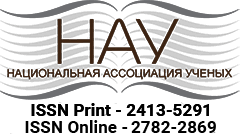METHODOLOGY OF FORMATION OF STUDENTS’ COMPETENCE IN WRITING LANGUAGE AND APPLICATION OF ITS EFFECTIVENESS IN DISTANCE LEARNING (26-28)
Номер части:
Оглавление
Содержание
Журнал
Выходные данные
Дата публикации статьи в журнале:
2020/07/14
Название журнала:Национальная Ассоциация Ученых,
Выпуск:
56,
Том: 1,
Страницы в выпуске:
26-28
Автор:
Smailova Zaure
1st course master student, the Kazakh Ablai Khan University of International Relations and World Languages, c.Almaty
1st course master student, the Kazakh Ablai Khan University of International Relations and World Languages, c.Almaty
Автор:
Kuanova Aigerim
Teacher, Department of education “Linguistic College”, c.Almaty
Teacher, Department of education “Linguistic College”, c.Almaty
Анотация: At present, distance learning courses are widely used in teaching foreign languages. Thanks to its authenticity, mastery of all aspects of language (lexical, phonetic and grammatical) and four types of speech activity (speaking, reading, listening, writing) occurs. Depending on the functional - stylistic direction, it allows you to develop all the communicative competencies, namely linguistic, sociolinguistic, sociocultural, strategic, social and discursive. This article described the methodology for the formation of competence of students in written language and tested its efficiency in remote learning. Also, distance and traditional forms of learning were compared.
Ключевые слова:
competence;
distance learning; traditional learning; written language;
Данные для цитирования: Kuanova Aigerim . METHODOLOGY OF FORMATION OF STUDENTS’ COMPETENCE IN WRITING LANGUAGE AND APPLICATION OF ITS EFFECTIVENESS IN DISTANCE LEARNING (26-28). Национальная Ассоциация Ученых.
Проблемы Педагогических наук. 2020/07/14;
56(1):26-28
- PDF версия
- Текстовая версия
Скачать в формате PDF
Список литературы: 1. Әбдіғали С.Ә. Әдістеменің кейбір өзекті мәселелері. Әдістеме. – Алматы: Абылай хан атындағы ҚХҚ және ӘТУ, 2005.
2. Говорова В.Ф. Методика развития умений письменной речи студентов факультетов иностранных языков в контексте речеведения (на материале английского языка). Автореф. дис. канд. пед. наук. — Тольятти, 2002 - 24 с. 41.
3. Зимняя И.А. Репродуктивность и продуктивность в обучении иностранному языку // Иностранные языки в школе - 1992 - № 1 - С. 16-20.
4. Шадурский В. Г., Межкультурная коммуникация и профессионально ориентированное обучение иностранным языкам.– Минск, 2009.– 325 с.
